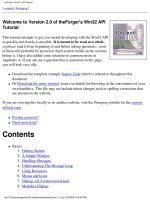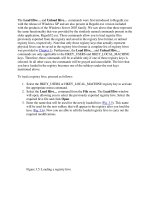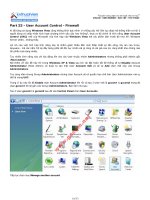leica user manual english version 2 0
Bạn đang xem bản rút gọn của tài liệu. Xem và tải ngay bản đầy đủ của tài liệu tại đây (1.3 MB, 38 trang )
User Manual
English
Version 2.0
Leica NA2/NAK2
NA2/NAK2-2.0.0en
2
This manual contains important safety directions as well as
instructions for setting up the product and operating it. Refer to
"Safety Directions" for further information.
Read carefully through the User Manual before setting up the
product.
Congratulations on your purchase of a NA2/NAK2 automatic
level.
Automatic level
Automatic level
NA2/NAK2-2.0.0en
3
The model and the serial number of your product are indicated on
the housing.
Enter the model and serial number in your manual and always refer
to this information when you need to contact your agency or Leica
Geosystems authorized service workshop.
Type: Serial no.:
Product identification
Product identification
NA2/NAK2-2.0.0en
4
The symbols used in this manual have the following meanings:
DANGER:
Indicates an imminently hazardous situation which, if not
avoided, will result in death or serious injury.
WARNING:
Indicates a potentially hazardous situation or an unintended
use which, if not avoided, could result in death or serious
injury.
CAUTION:
Indicates a potentially hazardous situation or an unintended
use which, if not avoided, may result in minor or moderate
injury and/or appreciable material, financial and environ-
mental damage.
Important paragraphs which must be adhered to in practice
as they enable the product to be used in a technically
correct and efficient manner.
Symbols
Symbols used in this manual
NA2/NAK2-2.0.0en
5
Introduction 7
Measurement preparation 10
Measuring 14
Checking and adjusting 20
Care and Storage 22
Safety Directions 25
Accessories 32
Technical Data 34
Index 35
View of chapters
View of chapters
NA2/NAK2-2.0.0en
6
Contents
Introduction 7
Special features 7
Important parts 8
Technical terms and abbreviations 9
Measurement preparation 10
Case contents 10
Setting up the tripod 11
Levelling up 12
Focusing telescope 13
Centring 13
Measuring 14
Height reading 14
Distance measuring 15
Angle measuring 15
Line levelling 16
Area levelling 17
Levelling total station measuring 18
Levelled stakeout 18
Precise levelling 19
Checking and adjusting 20
Tripod 20
Circular level 20
Checking and adjusting of the
line-of-sight 21
Care and Storage 22
Transport 22
In the field 22
Inside vehicle 23
Shipping 23
Storage 23
Cleaning 24
Safety Directions 25
Intended use of instrument 25
Permitted uses 25
Adverse uses 25
Limits of use 26
Responsibilities 27
Hazards of use 28
Accessories 32
Technical Data 34
Index 35
Contents
NA2/NAK2-2.0.0en
Introduction
7
Introduction
Special features
NA-01
The NA2/NAK2 universal
automatic level meets all
precision, convenience and
reliability requirements.
It‘s innovative technology will
make daily surveying jobs
easier.
The instrument is ideally suited
for all levelling applications and
at all orders of accuracy.
The instantaneous check facility
with the push-button control
promotes confidence.
• Easy operation, quick to
learn!
• Robust and reliable.
• High setting accuracy.
• Endless drive.
• Telescope with excellently-
corrected optics for bright,
high-contrast images.
• Enables angle measurements
with internal glass circle
(NAK2 model).
• Optional parallel-plate
micrometer for precise fine
levelling.
NA2/NAK2-2.0.0en
Introduction
8
Important parts
1 Eyepiece of scale
microscope (NAK2 only)
2 Telescope eyepiece
3 Bayonet ring, locks
eyepiece in place
4 Open sight
5 Prism for viewing circular
level
6 Rapid/fine focussing knob
7 Objective housing
8 Push-button for compen-
sator control
9 Footscrew
10 Milled rim, for Hz-circle
setting (NAK2 only)
11 Circular level
12 Base plate
13 Endless horizontal drive
(both sides)
11
6
912
4 5
8 10
21
NA-02
3 7
13
NA2/NAK2-2.0.0en
Introduction
9
Technical terms and abbreviations
Backsight/Foresight/
Intermediate sight
For determining the height
difference (∆H) between the
ground points A and B the back
sight (R) is measured first
followed by the forward sight
(V). Additional points relating to
A are measured as intermediate
sight (S).
Plumb line
By centring the circular level the
instrument is almost level.
A small instrument tilt remains
(the vertical axis tilt).
Compensator
The compensator in the
instrument is responsible for
compensating the vertical axis
tilt enabling an exactly horizontal
aiming.
The push button gives the
pendulum a slight tap to check the
functioning of the compensator.
NA-05
NA 06
NA-04
A
B
R
V/S
(∆H)
Plumb line
Vertical
axis tilt
Plumb line
Line-of-sight
NA2/NAK2-2.0.0en
Measurement preparation
10
G
e
b
r
a
u
c
h
s
a
n
w
e
is
u
n
g
N
A
7
0
0
k
d
k
j
o
d
k
o
l
m
d
l
k
o
m
öm
l
k
o
k
1 Level
2 User Manual
3 Allen key/Adjusting pins
4 Protective cover & sun
shade
Remove NA2/NAK2 level from the case and check that all
components are present.
Case contents
Measurement preparation
NA-35
2
1
4
3
NA2/NAK2-2.0.0en
Measurement preparation
11
NA-07
NA-08
When setting up the
tripod pay attention to a
horizontal position of the
tripod plate.
Large inclinations of the tripod
must be corrected with the
footscrews of the tribrach.
Setting up the tripod
1. Loosen screws of tripod legs,
pull out to required length and
tighten screws.
2. In order to guarantee a firm
foothold sufficiently press the
tripod legs into the ground.
When pressing the legs into
the ground note that the force
must be applied along the
legs.
Careful handling of tripod
• Check all screws and bolts
for correct fit.
• During transport always use
the cover supplied.
Scratches and other
damages can result in poor
fit and measuring
inaccuracies.
• Use the tripod only for
surveying jobs.
1.
1.
1.
2.
2.
2.
NA-09
NA-10
NA-11
NA2/NAK2-2.0.0en
Measurement preparation
12
Levelling up
1. Place level onto tripod head.
Tighten central fixing screw of
tripod.
2. Turn footscrews of tribrach
into centre position.
3. Centre circular level by
turning the foot screws.
Centring the circular level
1. Turn foot screws A and B
simultaneously in opposite
directions until bubble is in
the centre (on the imaginary
"T").
2. Turn foot screw C until bubble
is centred.
NA-12
NA-13
NA-14
B
A
C
NA2/NAK2-2.0.0en
Measurement preparation
13
Focusing telescope
1. Aim telescope against a
bright background (e.g. white
paper).
2. Turn eyepiece until reticule is
sharp-focused and black.
Now the eyepiece is adjusted
to your eye.
3. Aim telescope on staff using
the coarse aiming device.
4. Turn focusing knob until
image of staff is sharply
focused. If the eye is moved
up and down behind the
eyepiece the image of the
staff and the reticule should
not move relative to each
other.
For centring over a ground
point:
1. Attach plumb bob.
2. Loosen central fixing screw
slightly and shift instrument
parallel on tripod until the
plummet is exactly over the
point.
3. Tighten central fixing screw.
Centring
NA-15
NA-16
NA-17
26
25
27
NA2/NAK2-2.0.0en
Measuring
14
1
0
Measuring
Before starting field work
or after longer periods of
storage/transport of your
equipment check the field
adjustment parameters specified
in this User Manual.
Reduce possible
vibrations by holding the
tripod legs.
If the optical parts of your
instrument are dirty of
fogged, your measurements can
be affected. Keep clean all optical
parts of your instrument and
follow the cleaning instructions
specified in the User Manual.
Before starting work, let
the instrument adjust to
the ambient temperature
(approximately 2 minutes per ºC
of temperature difference).
1. Setup instrument, level and
sharp-focus the reticule.
2. Setup level staff vertically
(refer also to Instruction
Manual of staff).
3. Roughly aim on staff using
the coarse aiming device.
4. Sharp-focus using the
focusing knob.
Height reading
5. Fine-aim on staff using the
endless drives.
6. Check if circular level is
centred (view level prism).
7. Press the button to verify that
the compensator is functio-
ning.
8. Read off height H at the
horizontal reticule hair.
Example above: H=1.143
d
NA-25
NA-18
H
H
11
12
10
NA2/NAK2-2.0.0en
Measuring
15
Result:
Distance d = 100 x L
Carry out steps 1 to 8 according
to height reading.
Reading:
Upper distance line: 1.216 m
Lower distance line: 1.068 m
Difference L: 0.148 m
Distance d: 14.8 m
Distance measuring
Circle reading 314°42’
The NAK2 is equipped with a
horizontal circle. The graduation
is 1° or 1 gon.
To measure an angle bring the
vertical hair of the reticule to the
centre of the staff.
By turning the milled ring, the
circle can be set to “0” or any
desired reading.
Angle measuring
Circle reading 392.66°
The circle is viewed through the
scale microscope and sharply
focussed by turning the
microscope eyepiece.
The Hz-angle is read from the
graduation line which protrudes
into the scale. Each scale line
represents 10’. The minutes are
read from the top scale line to
the circle graduation line.
NA-23
NA-26
NA-27
11
12
10
L
316
315
314
313
312
394
393
392
391
390
NA2/NAK2-2.0.0en
Measuring
16
Project:
Height difference (∆H) between
point A and B.
Select instrument station
and staff location by
pacing off such that approx. the
same target distances result (d1
≈ d2; approx. 40 to 50m).
Procedure:
1. Setup instrument at I
1
.
Line levelling
2. Setup level staff vertically at
point A.
3. Aim at staff and read off and
take down height (backsight
R).
4. Setup level at the
changepoint 2, aim at staff
and read off and take down
height (foresight V).
5. Setup level at I
2
, aim at staff
at the changepoint 2 and
read backsight and take
down.
6. Carry out a foresight at
changepoint 3.
7. Continue in the same way
until height at point B is
measured.
Result:
∆∆
∆∆
∆H = sum backsight - sum
foresight
Example of the booking:
NA-28
A
B
2
3
RV
RV
RV
I
1
I
2
I
3
d
1
d
2
∆H
Point
No.
Back-
sight R
Fore-
sight V
Height
A +2.502 650.100
2 +0.911 -1.803
3 +3.103 -1.930
B -0.981 651.902
Sum +6.516 -4.714
∆H=
+1.802
NA2/NAK2-2.0.0en
Measuring
17
Project:
Height difference of several
reference points.
The required accuracy is
usually not very high
with such measurements.
Nevertheless, from time to time
read the staff on a stable
intermediate point (reading must
remain the same).
Area levelling
Procedure:
1. Set up instrument centrally
between the desired points.
The instrument telescope
may not be below the highest
measured intermediate point.
2. Set up staff vertically at
reference point A.
3. Aim at staff and read and
take down height (=backsight
to known point).
4. Set up staff vertically at
point 1.
5. Aim at staff and read and
take down height
(=measuring intermediate
point, intermediate sight)
6. Repeat steps 4 and 5 for
additional intermediate
points.
Height =
Height of station point
+ backsight (A)
- intermediate sight
NA-29
R
S1
A
1
2
3
4
S2
S3
S4
7. The height of individual points
are:
Example of booking:
⊗ =Instrument horizon
Point
No.
Inte rm.
sight
Height
A 592.00
R1 +2.20
⊗
594.20
S1 -1.80 592.40
S2 -1.90 592.30
S3 -2.50 591.70
S4 -2.30 591.90
NA2/NAK2-2.0.0en
Measuring
18
Wanted:
Position of several ground
points.
The levelling total station
measuring is normally
carried out during area levelling.
Levelling total station measuring
Procedure:
1. Sequence of measurements
is the same as with area
levelling. However, beside the
height read also the staff
section L (see chapter
"Distance measuring") and
the Hz-angle.
2. Transfer measured value into
the map - points are
determined by position and
height.
Levelled stakeout
The stakeout is the counterpart
to the levelling total station
measuring - map points are set
out in the field.
Procedure:
1. Set up instrument at a known
point, centre and level up.
2. Focus instrument and aim on
known orientation point.
3. Orient horizontal circle (Hz-
direction).
4. Move staff to stakeout point
on the basis of known values
(distance and Hz-angle,
height) and stakeout point
NA-36
NA-37
R
A
1
2
Backsight to known point Measuring ground points
A
NA2/NAK2-2.0.0en
Measuring
19
Project:
Height difference of very high
accuracy.
Use the GPM3 parallel
plate micrometer and
invar levelling staffs.
In sloping terrain, the
lower part of the staff
should not be used, as
refraction close to the ground
can cause errors.
In sunny weather an
umbrella should be used
to shelter the instrument to
ensure that the level is
protected from the glare of the
sun.
Precise levelling
Procedure:
1. Sequence of measurements
is the same as with line
levelling. However, the best
observing length is approx.
25m.
2. When reading the staff, turn
the micrometer knob until a
graduation line is centred
between the wedge-shaped
hairs of the reticle.
3. Centimetres are read from
the staff and millimetres from
the micrometer scale.
4. Leica invar staffs have two
sets of graduations. These
are read alternatively
between foresight and
backsight. This provides two
independent results and
serves as a check.
Example above:
Staff reading = 77 cm
GPM3 reading = 0.556 cm
Height = 77.556 cm
NA-43
NA2/NAK2-2.0.0en
Checking and adjusting
20
12
Checking and adjusting
1. Level up instrument.
2. Turn instrument by 180°.
3. If bubble of level is outside
the circle then it should be
adjusted (see point 4).
NA-31
Circular level
Connection of individual
elements must always be tight.
1. Tighten the Allen screws (2)
moderately (if available).
2. Tighten the articulated joints
on the tripod head (1) just
enough to keep the tripod
legs open when you lift it off
the ground.
Tripod
NA-30
4. Correct the half error using
an adjusting pin and repeat
steps 2 and 3 until the bubble
of level is in the centre in any
telescope direction.
NA-32
∆
∆/2
1.
2.
3.
NA2/NAK2-2.0.0en
Checking and adjusting
21
Checking and adjusting of the line-of-sight
Checking (see figure):
1. Choose a flat terrain between
45 and 60 m ling and divide
into three equal sections d.
2. Set up a staff at points A & B.
3. Set up the level at point 1,
centre the bubble and press
the compensator button.
4. Readings A1 and B1 are
taken to the staffs.
5. Set up the level at point 2.
6. Readings A2 and B2 are taken
to the staffs.
7. Find nominal reading A2;
Reading A1 - B1 + B2
When the difference
nominal-/actual- reading is
more than 2 mm the line of sight
must be adjusted.
1. Screw off the protective cover.
2. Turn the adjusting screw until
the horizontal hair gives the
nominal reading A2 on staff A.
The last turn of the adjusting
screw should be clockwise.
3. Screw on the protective cover.
4. Repeat the checking
procedure.
NA-45
NA-44
dddAB
A2 B2
A1
B1
1
2
8. Compare the nominal-/actual-
reading for A2.
Parallel plate micrometer
When using the parallel plate
micrometer to perform precise
levelling, follow the same check
procedure using invar staffs and
micrometer reading. When
adjusting, the micrometer is set
to the correct value and the
adjusting screw is turned until
the horizontal hair is on the staff
graduation.
NA2/NAK2-2.0.0en
Care and Storage
22
When transporting or
shipping the equipment
always use the original Leica
Geosystems packaging
(transport case and shipping
cardboard).
After a longer period of
storage or transport of
your product always check the
field adjustment parameters
indicated in this manual before
using the product.
Care and Storage
Transport
In the field
When transporting the
equipment in the field, always
make sure that you
• either carry the product in its
original transport container,
• carry the tripod with its legs
splayed across your shoulder,
keeping the attached product
upright.
NA-19
NA-39
NA2/NAK2-2.0.0en
Care and Storage
23
Never carry the product loose in
a road vehicle, as it can be
affected by shock and vibration.
Always carry the product in its
transport container and secure
it.
Storage
Respect the temperature
limits when storing the
equipment, particularly in summer
if the equipment is inside a
vehicle. Refer to "Technical Data"
for information about temperature
limits.
If the equipment is to be
stored for a long time,
remove the alkaline batteries from
the GEB63 battery box in order to
avoid the danger of leakage.
Inside vehicle Shipping
When transporting the product
by rail, air or sea, always use
the complete original Leica
Geosystems packaging,
transport container and
cardboard box, or its equivalent,
to protect against shock and
vibration.
NA-22
NA-21
NA-20
+158° +70°
°F °C
+32° 0°
-40° -40°
NA2/NAK2-2.0.0en
Care and Storage
24
Cleaning
Objective, eyepiece:
• Blow dust off lenses and
prisms
• Never touch the glass with
your fingers
• Use only a clean, soft, lint-
free cloth for cleaning. If
necessary, moisten the cloth
with water or pure alcohol.
Storage, continued
If the instrument
becomes wet, leave it
unpacked. Wipe down, clean,
and dry the instrument (at not
more than 40 °C/ 104°F),
transport case, foam inserts,
and accessories. Pack up the
equipment only when it is
completely dry.
When using the instrument in
the field always close the
transport case.
Do not use other liquids; these
may attack the polymer
components.
NA-40
NA-24
NA2/NAK2-2.0.0en
Safety Directions
25
Safety Directions
The following directions should
enable the person responsible
for the product, and the person
who actually uses the
equipment, to anticipate and
avoid operational hazards.
The person responsible for the
product directions and adhere to
them.
Permitted uses
The level is intended to the
following applications:
• Line and area levellings
• Height readings
• Precision levelling with
attachable parallel-plate
micrometer
• Optical distance measuring
with stadia readings
• Angle measurements and
staking out with horizontal
circle (only NAK2 model)
Intended use of instrument
Adverse uses
• Use of the product without
instruction
• Use outside of the intended
limits
• Disabling safety systems
• Removal of hazard notices
• Opening the product using
tools, for example
screwdriver, unless this is
specifically permitted for
certain functions.
• Modification or conversion of
the product
• Use after misappropriation
• Use of products with
obviously recognizable
damages or defects









